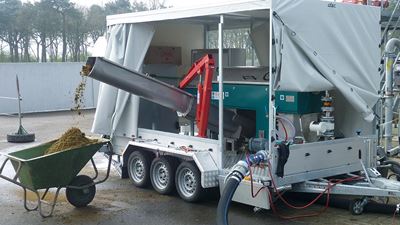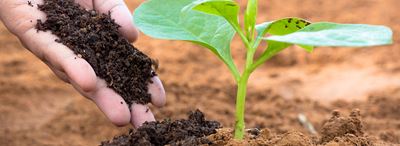Both residues from the fermentation of biomass and slurry from livestock farming are considered to be valuable fertilizers in modern agriculture. For spreading on agricultural land in a way that is not detrimental to the soil and in accordance with the strict legal requirements, the organic substances and associated excess nutrients must be processed appropriately. GEA provides the market with customer-friendly and demand-based processing concepts, which contribute to the sustainable reduction of environmental pollution.
Using decanters to produce high-quality fertilizers from fermentation residues
For the efficient processing of fermentation residues, our high-performance GEA decanters reliably separate solid particles, dewater them into a pourable dry consistency, and guarantee a high content of up to 30% dry substance in the solids. Compared with other technologies, there is no risk of blockage with centrifugal technology and the separation of solids is more efficient. Our customers benefit from lower transport and spreading costs, as the high separation efficiency of our decanters ensures a high proportion of organic content in the solids that are spread. Moreover, for lower fresh water consumption, the clear centrate water can be fed back into the fermentation process.
Reducing phosphate and nitrogen content with decanters
GEA decanters are also designed for processing raw slurry and offer users a range of advantages. They can be used to reduce phosphate and nitrogen content efficiently, for example from liquid pig slurry, by separating up to 75% of the phosphate compounds and up to 35% of the nitrogen compounds with the solids. The pourable solids can be composted and used as high-grade fertilizers. The liquid phase is transported to a silo for storage or spread on agricultural land.

Energy-efficient evaporation technology for economical concentration of raw slurry
Concentrating slurry in an evaporation plant has also been proven as effective to counter the surplus of slurry, particularly in cattle-strong rearing farms. In this process, the slurry is concentrated up to 30% dry substance in an evaporation plant then completely dried in a dryer. Both the evaporation plant and the dryer can be operated here entirely with the aid of waste heat, which is often available.
Advantages:
- Sustainable solutions for processing raw slurry and fermentation residues
- Decanter or evaporation plant – appropriate process technology for every customer
- Production of high-grade fertilizers for environmentally friendly spreading that is compliant with the strictest legal requirements
- Reduction of transport and spreading costs
- High content of dry substance in the solids that are spread
- Lower energy costs for the evaporation plant and dryer due to the use of waste heat
GEA further supplies equipment like jet and vacuum pumps for conveying liquids such as biological sludge or manure and solids such as sand and gravel.
製品および技術
9 の 4 を表示する

エジェクタシステム
エジェクタは、ガスや液体媒体が駆動力としての役割を果たすガス、蒸気、液体または固体の搬送、圧縮または混合のための装置です。これは「可動部品のないポンプ」です。

ガス圧縮機
GEAのガス圧縮機は、石油・ガス抽出と精錬作業用、ガスタービン装備の発電所用、化学処理やその他様々な産業用の、重要なシステムコンポーネントです。

コントロールモジュール
T.VIS® コントロールモジュールは、シリーズ VARIVENT®、ECOVENT® & T-smart の GEA バルブを制御および監視するための最適なシステムです。

サニタリ仕様バルブ & コンポーネント
GEA のサニタリ仕様バルブは、マトリックスパイププロセスプラントの中核コンポーネントを構成します。柔軟性の基準を設定する先駆的なバルブの概念と、最新の制御および自動化機能により、当社のバルブでは製造業者の最大限の製品の安全性とプロセスの信頼性が得られます。全ての GEA サニタリ仕様バルブは、その用途に対して効率的で費用対効果が高くなるよう設計されており、持続可能な操業と大幅な節約につながります。
Downloads
関連のある動画
GEA environmental Decanter pro
Mobile Decanter Systems
Nueva planta móvil GEA de tratamiento de purines - Cooperativa Pirenaica
GEAインサイト
Innovating patient care with aseptic spray drying
At GEA, our commitment to engineering for a better world fuels our pursuit of innovative solutions that enhance patient care and safety. One of our most promising ventures in recent years is aseptic spray drying – a technology...
レシチンが単なる副産物から主役に変貌を遂げるまで
GEA製品販売部長のパトリック・シュールマンにとって、レシチンは特別な存在です。当初は食用油の精製において脇役にすぎなかったものの、何にでも使える物質として、競争が激しく利益率の低い食用油精製市場で見事に主役の座を獲得。実はこれ、シュールマンが同僚と一緒に開発した、革新的で省エネな新製法によるところが大きいのです。

